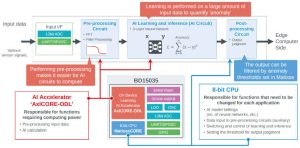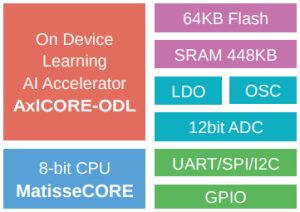“Until now it has been difficult to develop AI chips that can learn in the field consuming low power,” according to the company. This one is intended to use “artificial intelligence to predict failures in electronic devices equipped with motors and sensors in real-time.”
The chip, called BD15035 and effectively a proof-of-concept, runs a three-layer neural network on a combination of Rohm’s ‘tinyMicon MatisseCore’ 8bit processor core (see below) sharing a die with a 20,000 gate AI accelerator, together running an on-device learning algorithm developed by Professor Matsutani of Keio University. It comes in a 9 x 9 x 1.2mm TQFP48V package.
 “Combining the accelerator with the CPU enables learning and inference with power consumption of just a few tens of mW,” said Rohm. “This allows real-time failure prediction in a range of applications, since anomaly detection results [an ‘anomaly score’] can be output numerically for unknown input data at the site where equipment is installed, without involving a cloud server.”
“Combining the accelerator with the CPU enables learning and inference with power consumption of just a few tens of mW,” said Rohm. “This allows real-time failure prediction in a range of applications, since anomaly detection results [an ‘anomaly score’] can be output numerically for unknown input data at the site where equipment is installed, without involving a cloud server.”
The company has plans to incorporate its accelerator into various ICs for motors and sensors. Commercialisation is scheduled to start in 2023, with mass production in 2024.
In the mean time, the company will lend out Arduino-compatible evaluation boards, which also have Wi-Fi, Bluetooth and a 64kbit EEPROM, and can connect to sensors.
tinyMicon MatisseCore?
tinyMicon MatisseCore, where Matisse is for ‘micro arithmetic unit for tiny size sequencer’ is an 8bit CPU that Rohm developed to add intelligence to analogue ICs for IoT use. It has, according to the company, an instruction set optimised for embedded applications and to be compatible for modern compilers – towards fast arithmetic processing, small chip area and small code size.
High-reliability applications, such as those requiring qualification under the ISO 26262 and ASIL-D vehicle functional safety standards were in the designers’ brief, and proprietary real-time on-die debugging is included that “prevents the debugging process from interfering with program operation,”, said Rohm.


